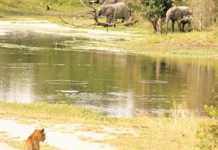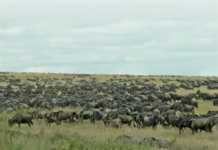
Contrary to popular belief, the quagga (Equus quagga quagga) is not a species in its own right.
It is simply a subspecies of the Burchell’s zebra or plains zebra. There are only three species of zebra in Africa: Burchell’s or plains zebra, mountain zebra, and Grevy’s zebra, found only in East Africa; all other zebra are subspecies of these.
DNA analysis of quagga kept as museum specimens, has proven that the extinct quagga was in fact a Burchell’s or plains zebra with a colour variation, in which some of its leg and rump stripes disappeared.
This also means that Burchell’s or plains zebra still carry genes from the extinct quagga, though these may be more diluted now than before.
Vanishing stripes
Why exactly the Burchell’s or plains zebra lost some of its stripes is unclear, but Quagga Project head co-ordinator, Craig Lardner, says that it could be possible that colour variations have to do with nutrition and the different vegetation types in various areas.
“The quagga that live on the West Coast are much paler in colour than those that live near Wellington and Hermon in the Western Cape,” he says.
This differing colouration seems to provide optimal camouflage: the quagga in each area blend better into their specific surroundings. Another purported reason for the quagga’s vanishing stripes, apart from camouflage and hence protection from predators, is tsetse flies.
It has been suggested that the zebra’s stripes repel tsetse flies and so too the diseases they carry. Because the quagga lived outside the tsetse fly areas, the distinct stripes became obsolete.
Quaggas were endemic to South Africa, and inhabited the Karoo and southern Free State, but because they competed for grazing with livestock, they were hunted to extinction by hunters and farmers in the late 19th century.
When it was discovered that the Burchell’s or plains zebra is a DNA match for the extinct quagga, the project set about attempting to ‘rebreed’ the quagga. This was done by selecting brownish zebra with reduced stripes and white tail bushes.
In this way, the quagga genes could be concentrated to produce an animal that looks precisely like the ‘extinct’ quagga.
Only mitochondrial DNA was available from museum specimens and not nuclear and living DNA. For this reason, it was impossible to compare the rebred quagga to the original ones that became extinct.
Nonetheless, the quagga in the Western Cape are believed to be the ‘real thing’, as it was in fact only coat pattern that distinguished a quagga from a Burchell’s or plains zebra.
Thus the Quagga Project seems to have succeeded in rectifying the tragedy that saw them being hunted to extinction.
Birth of the project
German-born taxidermist, Reinhold Rau, who started working on constructing mammal, bird, fish and reptile displays for the SA Museum in Cape Town in 1951, became fascinated by a quagga foal in 1969 while remounting it.
This was the only remaining specimen in the museum’s collection. He collected dried tissue samples from the foal’s skin, and together with samples from quagga in the Natural History Museum in Mainz, Germany, and others he had previously remounted, were sent for DNA analyses at the University of California, Berkeley.
The results showed the quagga to be part of a southern population of the Burchell’s or plains zebra, which meant it could be ‘resurrected’ with selective breeding for coat colour.
It was found that plains zebras from Etosha in Namibia looked similar to the extinct quagga, as did some plains zebra in Umfolozi Game Reserve in KwaZulu-Natal.
With the assistance of South African National Parks, zebra from these two sources were translocated to the Western Cape and the breeding project commenced in 1987.
“Rau estimated it would take five generations or 25 years to breed a quagga, but the quagga was rebred in just three generations,” says Lardner. In 2005, the foal Henry was born at Pampoenvlei in the Western Cape.
This is the first animal that met the quagga colouration requirements as set down by Prof Eric Harley, an authority on genetics. Rau saw the realisation of his dream before his death in 2006.
Today, the project has 100 animals in its breeding programme, with 14 of them classified as Equus quagga quagga.
Quagga colour criteria
While the colouration requirements are stringent, and include counting stripes on certain sections of the animal’s coat, the general criteria include: degenerative striping from the rump down, no stripes crossing the ventral line under the stomach, and stripes that are more fawn in colour than bright black and white.
“When Prof Harley was working out what constitutes a quagga, he kept coming across a small stripe on the hock,” explains Lardner.
Then he found that renowned naturalist Charles Darwin had documented that, from time to time quagga did have a stripe on the hock. “Darwin used quagga as an example to explain variations in a species. This is also the earliest record that mentions the quagga that I know of,” says Lardner.
He adds that when a foal is born “you don’t know at first exactly what its colouration will be – sometimes stripes only appear later”. Should the quagga be placed back with Burchell’s or plains zebras, their offspring would most likely develop additional stripes, as the quagga genes would be diluted through interbreeding.
In the wild
“However, our intention is to release quagga back into the wild in areas where they lived naturally, such as the Karoo National Park, and where they won’t cross- breed with other zebra. We already have quagga in a management area bordering the Agulhas National Park,” explains Lardner.
He adds that the Khumba animated film – the story of a zebra born with only half his stripes – helped to bring awareness of the project to the public.
Lardner and his team have also placed a bachelor herd of four quagga at Rhodes Memorial in the Table Mountain National Park, “so the public can see them in the flesh”.
The project’s largest quagga population is at Elandsberg near Hermon, and there are quagga on Bontebok Ridge near Wellington. Both populations are accessible to the public.
A unique, viable project
Lardner has been involved with the Quagga Project since 2003. After Rau’s death in 2006, Lardner took over the reigns of the project and it is now run as a Section 21, non-profit company. “We work professionally and formally, and animals are captured using helicopters, not darted from the back of bakkies,” he explains. “We sold off some animals without potential and gave the project a financial boost, so we’re financially stable and also receive valuable donations.
“The project may have started out as a fascination for Rau, but it has spread among those who didn’t want to see the quagga lost forever – and now it’s a scientific project. While quagga may not be essential in the food chain, it’s good to know they’re back and we haven’t lost this animal that is thoroughly South African – quagga occurs nowhere else on earth.”













